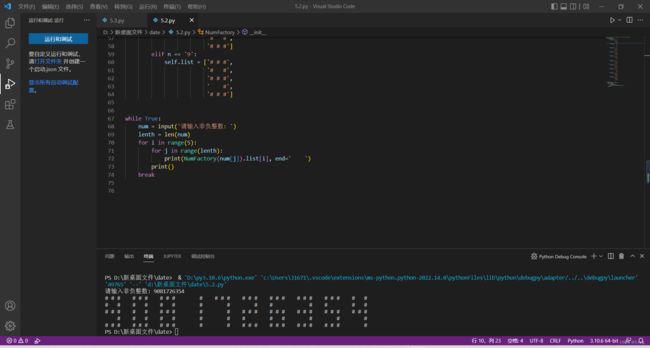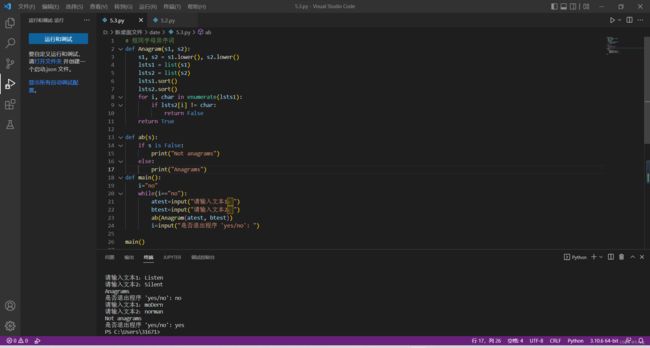python联系之用#代表LED显示及相同字母异序词判断
一、实验内容
1.Scenario
You've surely seen a seven-segment display.
It's a device (sometimes electronic, sometimes mechanical) designed to present one decimal digit using a subset of seven segments. If you still don't know what it is, refer to the following Wikipedia article.
Your task is to write a program which is able to simulate the work of a seven-display device, although you're going to use single LEDs instead of segments.
Each digit is constructed from 13 LEDs (some lit, some dark, of course) - that's how we imagine it:
Note: the number 8 shows all the LED lights on.
Your code has to display any non-negative integer number entered by the user.
Tip: using a list containing patterns of all ten digits may be very helpful.
Test data
Sample input:
9081726354
Sample output:
- An anagram
An anagram[相同字母异序词]is a new word formed by rearranging the letters of a word, using all the original letters exactly once. For example, the phrases "rail safety" and "fairy tales" are anagrams, while "I am" and "You are" are not.
Your task is to write a program which:
- asks the user for two separate texts;
- checks whether, the entered texts are anagrams and prints the result.
Note:
- assume that two empty strings are not anagrams;
- treat upper- and lower-case letters as equal;
- spaces are not taken into account during the check - treat them as non-existent
Test your code using the data we've provided.
Test data
Sample input:
Listen
Silent
Sample output:
Anagrams
Sample input:
modern
norman
Sample output:
Not anagrams
- 实验代码
1.# 相同字母异序词
# 相同字母异序词
def Anagram(s1, s2):
s1, s2 = s1.lower(), s2.lower()
lsts1 = list(s1)
lsts2 = list(s2)
lsts1.sort()
lsts2.sort()
for i, char in enumerate(lsts1):
if lsts2[i] != char:
return False
return True
def ab(s):
if s is False:
print("Not anagrams")
else:
print("Anagrams")
def main():
i="no"
while(i=="no"):
atest=input("请输入文本1:")
btest=input("请输入文本2:")
ab(Anagram(atest, btest))
i=input("是否退出程序 'yes/no': ")
main()2.模拟led显示
#编写一个能够模拟七个显示设备的工作的程序,每个数字都是由13个led构成的
class NumFactory():
def __init__(self, n):
if n == '0':
self.list = ['# # #',
'# #',
'# #',
'# #',
'# # #']
elif n == '1':
self.list = [' #',
' #',
' #',
' #',
' #']
elif n == '2':
self.list = ['# # #',
' #',
'# # #',
'# ',
'# # #']
elif n == '3':
self.list = ['# # #',
' #',
'# # #',
' #',
'# # #']
elif n == '4':
self.list = ['# #',
'# #',
'# # #',
' #',
' #']
elif n == '5':
self.list = ['# # #',
'# ',
'# # #',
' #',
'# # #']
elif n == '6':
self.list = ['# # #',
'# ',
'# # #',
'# #',
'# # #']
elif n == '7':
self.list = ['# # #',
' #',
' #',
' #',
' #']
elif n == '8':
self.list = ['# # #',
'# #',
'# # #',
'# #',
'# # #']
elif n == '9':
self.list = ['# # #',
'# #',
'# # #',
' #',
'# # #']
while True:
num = input('请输入非负整数: ')
lenth = len(num)
for i in range(5):
for j in range(lenth):
print(NumFactory(num[j]).list[i], end=' ')
print()
break- 设计思路
- 先定义个判断函数将输入的两个单词先变成小写再转化成列表并排序,由于字母个数相同,只需挨个比较,相同则Anagrams,反之,Not anagrams。
- 定义一个类,将对应的0-9的LED形式表示出来,利用循环挨个将输入数字的对应LED形式打印即可。
- 实验截图

